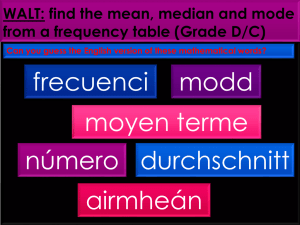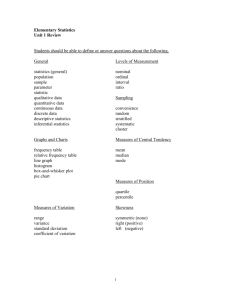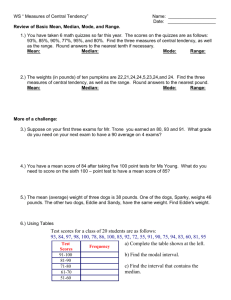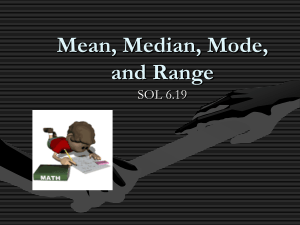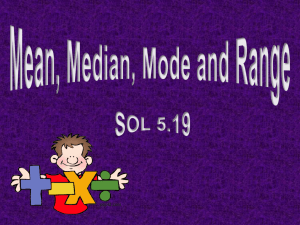Weighted Means and Grouped Data
advertisement
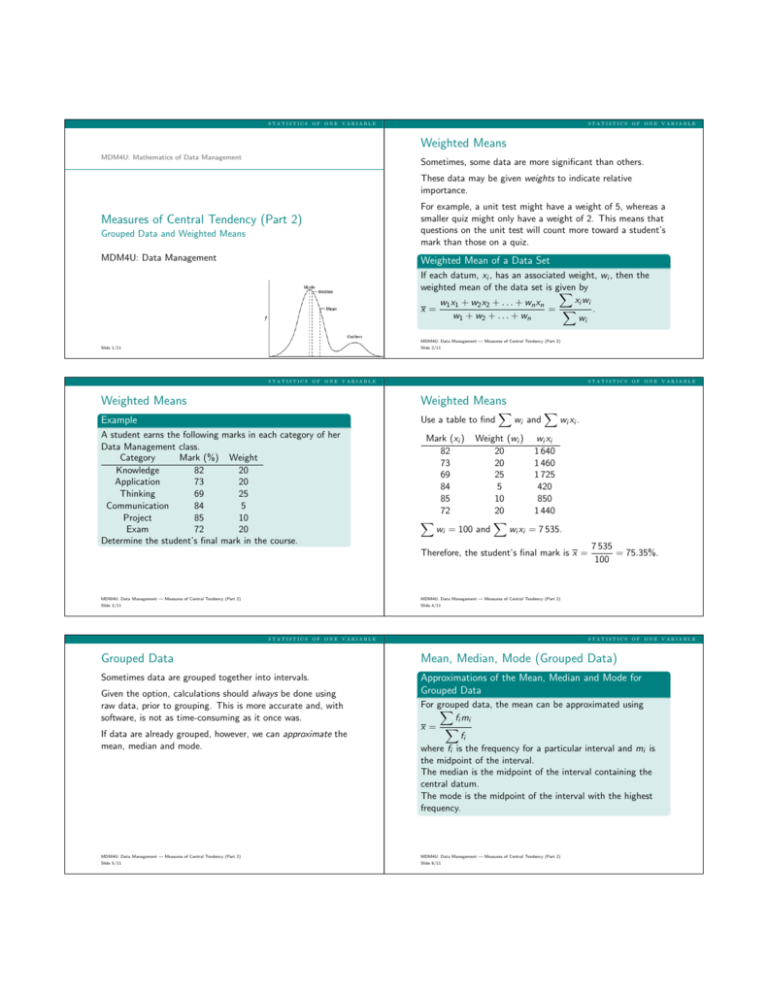
statistics of one variable statistics of one variable Weighted Means MDM4U: Mathematics of Data Management Sometimes, some data are more significant than others. These data may be given weights to indicate relative importance. Measures of Central Tendency (Part 2) Grouped Data and Weighted Means MDM4U: Data Management For example, a unit test might have a weight of 5, whereas a smaller quiz might only have a weight of 2. This means that questions on the unit test will count more toward a student’s mark than those on a quiz. Weighted Mean of a Data Set If each datum, xi , has an associated weight, wi , then the weighted mean of the data set is given X by xi wi w1 x1 + w2 x2 + . . . + wn xn x= = X . w1 + w2 + . . . + wn wi MDM4U: Data Management — Measures of Central Tendency (Part 2) Slide 2/11 Slide 1/11 statistics of one variable statistics of one variable Weighted Means Weighted Means Example Use a table to find A student earns the following marks in each category of her Data Management class. Category Mark (%) Weight Knowledge 82 20 Application 73 20 Thinking 69 25 Communication 84 5 Project 85 10 Exam 72 20 Determine the student’s final mark in the course. Mark (xi ) Weight (wi ) 82 20 73 20 69 25 84 5 85 10 72 20 X X wi = 100 and wi xi X wi and X wi xi . wi xi 1 640 1 460 1 725 420 850 1 440 = 7 535. Therefore, the student’s final mark is x = 7 535 = 75.35%. 100 MDM4U: Data Management — Measures of Central Tendency (Part 2) Slide 4/11 MDM4U: Data Management — Measures of Central Tendency (Part 2) Slide 3/11 statistics of one variable statistics of one variable Grouped Data Mean, Median, Mode (Grouped Data) Sometimes data are grouped together into intervals. Approximations of the Mean, Median and Mode for Grouped Data Given the option, calculations should always be done using raw data, prior to grouping. This is more accurate and, with software, is not as time-consuming as it once was. If data are already grouped, however, we can approximate the mean, median and mode. MDM4U: Data Management — Measures of Central Tendency (Part 2) Slide 5/11 For grouped data, the mean can be approximated using X fi mi x= X fi where fi is the frequency for a particular interval and mi is the midpoint of the interval. The median is the midpoint of the interval containing the central datum. The mode is the midpoint of the interval with the highest frequency. MDM4U: Data Management — Measures of Central Tendency (Part 2) Slide 6/11 statistics of one variable statistics of one variable Mean, Median, Mode (Grouped Data) Mean, Median, Mode (Grouped Data) Example Make a frequency table. Surveys about television viewing habits are mailed to 1 000 individuals. Of these, 500 are returned with the following results. Hours/day 0-1 2-3 4-5 6-7 8-9 10-11 12-13 Frequency 64 92 141 86 71 35 11 Calculate the mean, median and mode of the data, and identify any problems with the data. Interval 0-1 2-3 4-5 6-7 8-9 10-11 12-13 Midpoint (xi ) 0.5 2.5 4.5 6.5 8.5 10.5 12.5 Frequency (fi ) 64 92 141 86 71 35 11 statistics of one variable Mean, Median, Mode (Grouped Data) fi = 500 and X fi xi 32 230 634.5 559 603.5 367.5 137.5 MDM4U: Data Management — Measures of Central Tendency (Part 2) Slide 8/11 MDM4U: Data Management — Measures of Central Tendency (Part 2) Slide 7/11 X Cumulative 64 156 297 383 454 489 500 fi xi = 2 564. statistics of one variable Mean, Median, Mode (Grouped Data) Example (Continued) The interval with the highest frequency is also the 4-5 hour interval, so the mode is 4.5 hours/day. There are a few problems with the data. The data are grouped, and we do not have access to the raw data. This means that the mean, median and mode are approximations. The intervals are not well-chosen. For example, there are no intervals for 1-2 hours/day, 3-4 hours/day, etc. This may result in inaccurate data values. The survey is voluntary, and only half were returned. This opens up the possibility for non-response bias in the survey. MDM4U: Data Management — Measures of Central Tendency (Part 2) Slide 9/11 MDM4U: Data Management — Measures of Central Tendency (Part 2) Slide 10/11 2 564 x= ≈ 5.1 hours/day. 500 The median is the central datum. Since there are 500 values, the median will be the midpoint of the 250th and 251st data. Both of these data occur in the 4-5 hour interval, so the median is 4.5 hours/day. statistics of one variable Questions? MDM4U: Data Management — Measures of Central Tendency (Part 2) Slide 11/11


